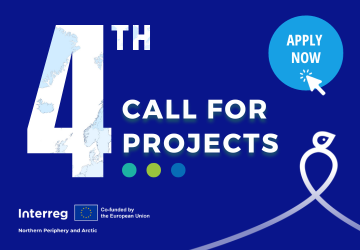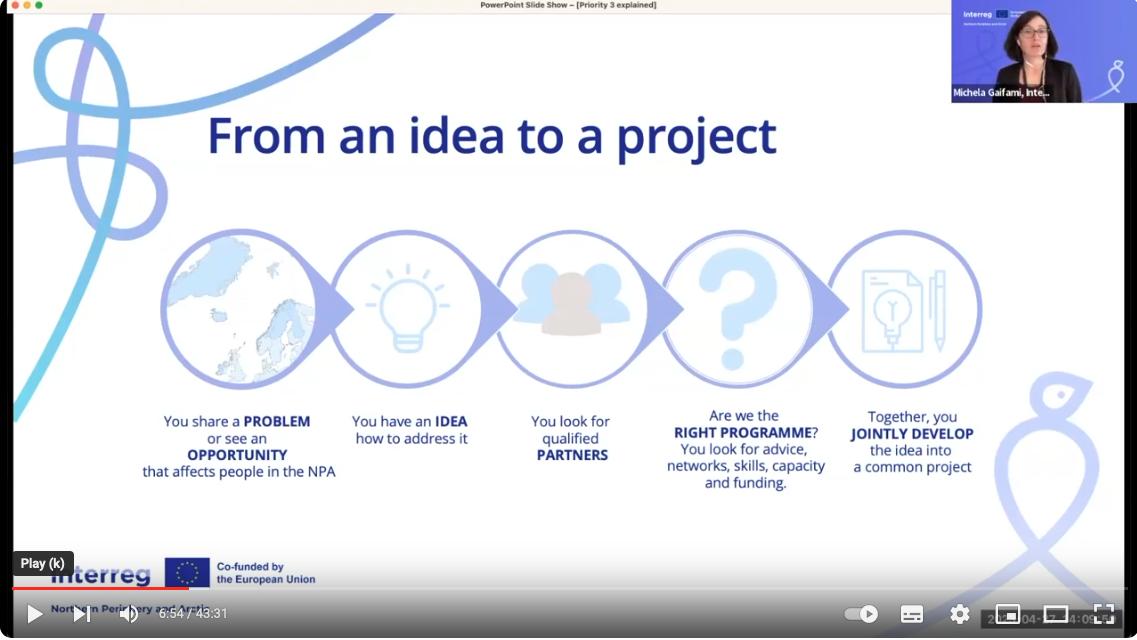Applying for funds
The NPA 2014-2020 programme has allocated 95% of the NPA funding for projects, including Main and Preparatory project types. 58 Main projects were approved in total and 94 preparatory projects, including Bridging projects. Information about each project can be found here.
Applying with Interreg NPA 2021-2027
Between 2021 and 2027, the Programme will allocate 46 833 778 Euros to projects, of which 39 978 162 EUR in European funding (ERDF) will be available to partners in Member States (Finland, Ireland, Sweden) and 6 855 616 EUR for partners in the Non-EU partner countries (Norway, Iceland, Faroe Islands, Greenland).
The funding available for projects has been distributed as follows:
- Priority 1 Innovation capacity: 45%
- Priority 2 Climate change and resource sufficiency: 45%
- Priority 3 Cooperation opportunities: 10%
The Programme is financed through European Regional Development Fund (ERDF) and ERDF equivalent funding from the Non-EU partner countries, supplemented by match funding from projects. Projects apply to the Programme for ERDF or ERDF equivalent co-financing and contribute to the project with public or private match funding.
The funding will be allocated through Calls for projects open at regular intervals each year.
Prospective Calls
Calls for project applications will be launched in the framework of the Interreg Northern Periphery and Arctic 2021-2027 programme. Calls will open regularly, two per year from 2022 onwards, indicatively in March and October each year.
Calls for applications will be announced on the NPA website well in advance of the deadline, so it is worth checking for regular updates. Relevant information will also be distributed by the Regional Contact Points and Monitoring Committee members. Additional promotional material and activities may be used to widely publicise the calls.
Planned calls (All dates subject to approval by the Monitoring Committee).:
- The 4th call for project proposals (all priorities) will run from 11th October to 2nd February 2024, with expected decision in May 2024.
- The 5th call for project proposals will run from 11th June 2024 to 30th September 2024, with expected decisions in December 2024.
The Monitoring Committee may decide on a specific focus or special requirements for individual calls. The call for applications and guidance will clearly outline any special requirements.
Further information and instructions for applying will be published in due course. For more information about the Interreg NPA 2021-2027 programme, please follow this link.
In general, the programme is open for public and private partners of all kinds from inside the programme area, for example regional and local authorities and other public sector organisations, research institutions and private entities delivering public service, private-public partnerships, social enterprises, and third sector organisations. Besides that, local and regional SMEs, among these specifically micro enterprises in remote and sparsely populated areas and business organisations, etc.
Eligible partners include:
- National, regional and local authorities
- Regional and local development agencies, chambers of commerce
- Universities, colleges, higher education, research institutions
- Non-governmental organisations (NGOs)
- Sectoral agencies and business support organisation
- Voluntary sector organisations
- Other relevant organisations contributing to the development of the programme area
- Micro, and small and medium sized enterprises (SMEs)
Ensuring the correct mix of transnational partners in a project is crucial to achieving genuine transnational cooperation and successful results. In general, all partners should have the capacity and knowledge in the project subject area to participate fully and to deliver the products and/or services.
For main projects, at least three eligible project partners from three different programme partner countries are required, of which one must be from an EU Member State. In addition, all partners need to have the administrative and adequate resources required to participate in a transnational projects. Furthermore, all partners are required to provide supporting documents required by the MA, Joint Secretariat, Controllers, or auditors.
Projects shall first of all address the main challenges and potentials of the programme area.
The Programme area is characterised by shared and common development resources, including the area’s abundant natural resources, high quality biophysical environment, and versatile business sector. However, in terms of development challenges and opportunities, peripherality combined with low population density is identified as the key shared challenge for the Programme Area. A range of development issues, such as weak access to key markets, lack of critical mass and higher costs for service delivery and influences the NPA region’s local economies, rural development, demography, labour markets and governance.
The aim of the Interreg NPA Programme is to foster change within the wider Programme Area, not only for project team members directly involved in the approved projects. Projects are expected to deliver viable outputs, whose impact should contribute to programme level results. Each of the Priorities have been designed to focus project applicants on delivering tangible, durable outputs, assisting the delivery of the programme’s ambitions of measurable positive changes in the Programme area. Each project's intended results and outputs are expected to facilitate the changes sought by the Interreg NPA Programme.
To align with the Programme’s results sought, each project should select the most appropriate Priority, and inside this, the most appropriate specific objective. See chapter 2 of the Programme Manual for an explanation of actions supported and output indicators under each specific objective, e.g. as attitude change, an openness to new approaches, an improved entrepreneurial business environment, a change in awareness and public policy or an increased preparedness. On programme level, the results are expressed and measured in result indicators. More information about expectations for project results and outputs can be found in chapter 2 and Annex 5 of the Programme Manual.
The Interreg NPA programme supports different project types, which are described below. Please note that eligibility and selection criteria vary depending on the different project types. Besides this, additional expectations and requirements may be included in the Terms of Reference for the call.
Main projects
Main projects are the standard project type supported by the Interreg NPA programme to achieve the objectives of the programme. Main projects typically have a transnational partnership of between 5-7 partners, an average budget size of 1 500 000 EUR, and an implementation period of 3 years. Main projects are expected to develop concrete project outputs, such as jointly developed solutions, which have a positive impact on the project’s target groups
Preparatory projects to develop main projects
Preparatory projects are an important tool for development of strong and well-balanced project partnerships in a dispersed geography where long distances and costs are obstacles for project development. Preparatory projects bring potential project partners together to generate high-quality main project applications. Experience from previous programme periods has shown that preparatory projects often result in more successful main project applications. Typically, a preparatory project has a total budget of up to 100 000 EUR, and runs for 6-12 months.
Preparatory projects for capacity building in Priority 3 (ISO 1)
Preparatory projects can also be a tool for building up capacity and experience for representatives of specific underrepresented groups (e.g. young people, and indigenous peoples) in relation to the Interreg NPA programme. On the one hand, the ambition is that partners shall become better suited for engagement in main projects as partners in the future. On the other hand, these smaller projects might complement main projects and support the Programme to foster changes that are of importance for people living in the programme area. Typically, a capacity building preparatory project has a total budget of up to 200 000 EUR, and runs for 6-18 months.
Clustering projects
Clustering projects are a means of diversifying and capitalising on outputs and results from two or more previously implemented or ongoing projects. Clustering projects are a tool to further integrate results as well as disseminate their impacts by reaching a wider group of stakeholders with project outputs, supplementary learning, and capacity building. During 2014-2020, clustering of projects has been used both for combinations of projects inside the programme, but also they have also allowed collaboration across programmes, in particular, Arctic clustering projects, in order to take advantage of synergies between projects funded by EU programmes in the Arctic. Typically, a clustering project has a total budget of up to 200 000 EUR, and runs for up to 12 months.
Besides the small-scale projects described above, the Monitoring Committee may decide on additional small project types on a call-by-call basis, for example, to further capitalise on project results


